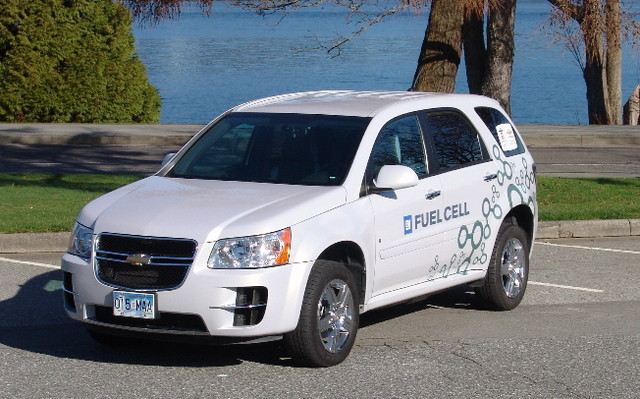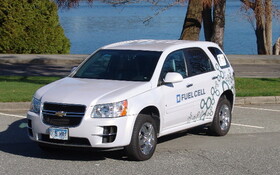Chevrolet Equinox Fuel Cell: An Olympic-calibre vehicle!
During the 2010 Olympic and Paralympic Games, people from around the world came together in beautiful Vancouver to celebrate culture and sport – and yes, even cars.
Respecting the pure spirit of the Games – and of course taking advantage of the world spotlight – several automobile manufacturers brought their hybrid vehicles to Vancouver. And believe it or not, the one that stood out the most was General Motors! As an official sponsor of the event, the ever-giant company from Detroit rolled in no less than 4,600 vehicles to transport athletes, dignitaries and organizers from one site to another.
Among these 4,600 vehicles were eight Chevrolet Equinox Fuel Cells, which run on hydrogen. And, you guessed it, the Car Guide team even got the chance to drive one of these very unique SUVs.
An entirely different podium
The first thing you need to know about this vehicle is that it sits at the crossroads of two different paths, particularly when it comes to its energy source. For 100-odd years, gasoline has been the car industry’s fuel of choice. But with clean energy being the order of the day (and with gas being far from clean), new directions must be explored.
Currently, several intensive studies are underway examining different alternative fuel types. And yet, a good 97% of the world’s cars still run on fossil fuels (gasoline, diesel, natural gas). Every new option seems like the perfect solution – until we realize it simply shifts the problem elsewhere. For example, it wasn’t so long ago that biofuel made from ethanol and corn looked like a sure bet, but since then we’ve come to realize that its use has serious repercussions on corn crops and, consequently, the survival of different human populations.
Among the other probable solutions is hydrogen (which goes by the H symbol), though there are several kinks left to work out before it can be widely distributed. I’ll come back to that point later. But to run a vehicle on hydrogen, you need three elements that, when combined, will create a chemical reaction. They are: a fuel cell, hydrogen and oxygen. The hydrogen and oxygen combine in the fuel cell, which contains anodes, cathodes, and, between them, two catalysers separated by a plastic membrane called the Proton Exchange Membrane. Then a chemical reaction is produced and electricity is created. The product of this reaction, other than electricity, is water, which is expelled via a system that is quite a bit like a regular exhaust. The energy created is sent to the electric engine, which relays the power to the front wheels (the Hydrogen Equinox is not available in AWD, unlike its gas-powered counterpart).
In February 2008, we were given the opportunity to visit the plant located in Oshawa Ontario where the Equinox Fuel Cell vehicles were being assembled (they’re still made there). We learned that the engineers had taken a Chevrolet Equinox from the previous year (two years ago, that was the current model), taken out the engine, transmission, exhaust and a good portion of the rear chassis. Before installing the new material, they had to make considerable modifications to the underbelly of the vehicle so that, later in the process, there would be enough room to add the carbon-fibre fuel tanks. Then they installed the drivetrain, the NiMH hydride battery pack (1.8 kWh), the tanks holding up to 4.2 kg of hydrogen gas, and the computer system that manages it all.
So, it was during a brief test drive in Stanley Park that we were able to drive one of these hydrogen-powered Equinoxes (if you can call it driving...). I won’t say much about the way it handles, since it really felt like driving... an SUV, pure and simple! And since it didn’t have a gas engine, it was a little like driving a hybrid or electric vehicle.
However, the different systems that control the hydrogen section are louder than an electric engine. This is particularly noticeable when you turn the key to stop the engine. First, any humidity is expulsed to ensure that no condensation remains in the ducts and causes rust. There’s even an audible "poosh" sound as the vapour is released from slits in the bumper. Replacing a regular exhaust, these vertical slits add a certain style to the vehicle. Then you hear a sort of "click-click-click" coming from under the hood for about 30 seconds. It’s the hydrogen injectors going off. If the Equinox ever hits the market with its hydrogen system, most of these sounds will be eliminated. But since these were just prototypes, they were no big deal.
A problem with supply?
During the Olympics, there were only two hydrogen pumps to supply all eight Equinox Fuel Cells. And since each fully fuelled vehicle was good for about 300 km, they had to stop by the pump at least twice a day. For security reasons (hydrogen is not handled the same way gas is), each pump had to be calibrated by GM. When filling up with hydrogen, the interior temperature of the tanks rises very quickly. An onboard computer and another one inside the pump "communicate" and slow down the flow if the temperature gets too high. And once the pressure inside the tanks reaches 10,000 lbs/square inch, it stops altogether. That said, the tanks can handle up to 40,000 lbs/square inch, but GM is leaving itself a very big margin. Incidentally, each tank has an ultra-resistant envelope that is at least an inch (25 mm) thick.
Since the Equinox Fuel Cell project began, 115 of these vehicles have been built. Aside from the units that made their way to the Vancouver Olympics, most of these Equinoxes have been tested by consumers in New York, Washington D.C. and southern California. Together they’ve accumulated some 1.7 million kilometres. What’s more, according to GM, they’ve already saved some 189,000 litres of gas.
Still short of perfection…
Despite this idyllic scenario, hydrogen technology has yet to win everyone over. Many experts have pointed to the huge hydrogen storage and distribution challenges. To keep the eight Equinoxes running in Vancouver (the city also has hydrogen buses, but they’re not part of the GM fleet), this precious gas has to be trucked in from Trois-Rivières, Quebec! It should also be noted that 96% of the hydrogen is produced using fossil fuels, according to a February 24, 2010 report in La Presse. To create the hydrogen, a water molecule (H20) has to be separated into two hydrogen molecules and one oxygen molecule, a process that requires a lot of energy – energy that is supplied by fossil fuels. In short, hydrogen vehicles may have excellent environmental prospects, but almost as much pollution is generated to get them going.
Despite these drawbacks, hydrogen vehicles may well hit the market one day, provided that the hydrogen transformation and infrastructure problems are resolved first. Until then, we’ve still got the good ol’ hybrids!












